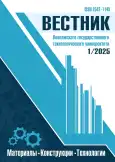Comparison of thermal insulation properties in different types of insulation used for apartment block construction
- Authors: Anisimov S.N.1, Lomonosova T.I.1, Ilina I.R.1, Leshkanov A.I.1
-
Affiliations:
- Volga State University of Technology
- Issue: No 1 (2025)
- Pages: 19-28
- Section: Materials
- URL: https://journal-vniispk.ru/2542-114X/article/view/303814
- DOI: https://doi.org/10.25686/2542-114X.2025.1.19
- EDN: https://elibrary.ru/OCUBTH
- ID: 303814
Cite item
Full Text
Abstract
Introduction. In the current state of sustainable development and increasing energy consumption, the selection of the most energy-efficient insulation is increasingly relevant. Insulation efficiency is a crucial consideration for both the construction of new buildings and for renovation of existing ones. The choice of insulation is often determined primarily by cost or availability, resulting in unfavourable outcomes. Therefore, when choosing the material, one should evaluate criteria such as thermal insulation capabilities, moisture resistance, vapour permeability, and the environmental safety of materials. Modern technologies offer a wide range of insulation materials, ranging from traditional mineral wool to cutting-edge eco-polymer solutions. Each option possesses distinct advantages and disadvantages, necessitating thorough investigation prior to decision-making. Thus, the importance of choosing the right insulation cannot be underestimated. Effective insulation not only reduces heating costs, but also fosters a more sustainable and eco-friendly construction industry, thereby directly influencing individual quality of life.
The aim of research is to comparatively analyse the results of a study of various thermal insulation materials for enclosing structures, aimed at identifying the most effective insulation materials in terms of the price-thermal properties ratio.
Materials and methods. The study evaluated the thermal insulation characteristics, moisture resistance, fire resistance, durability of several insulation materials, and the expenses associated with insulating an apartment block in Yoshkar-Ola. Seven thermal insulation materials were chosen for comparison: mineral (stone) wool (75-120 kg/m³); glass wool slab P-85; extruded polystyrene foam (EPS) (40 kg/m³); expanded polystyrene PSB-50; polystyrene concrete (200 kg/m³); autoclaved aerated concrete (D600); and ecowool (60 kg/m³).
Conclusions. Research revealed that mineral wool insulation can be regarded as the most effective thermal insulation material. Besides its excellent thermal insulation capabilities and affordability, mineral wool possesses other features that make it particularly appealing for construction applications.
About the authors
Sergei Nikolaevich Anisimov
Volga State University of Technology
Author for correspondence.
Email: AnisimovSN@volgatech.net
Candidate of Engineering Sciences, Associate Professor of the Department of Construction Technologies and Roads
Russian Federation, Yoshkar-OlaTatiana Ionovna Lomonosova
Volga State University of Technology
Email: LomonosovaTI@volgatech.net
Candidate of Engineering Sciences, Associate Professor of the Department of Construction Technologies and Roads
Yoshkar-OlaIrina Rodionovna Ilina
Volga State University of Technology
Email: IlyinaIrina231@gmail.com
Master's student of the Department of Construction Technologies and Roads
Yoshkar-OlaAndrei Iurevich Leshkanov
Volga State University of Technology
Email: LeshkanovAI@volgatech.net
Candidate of Engineering Sciences, Associate Professor of the Department of Construction Technologies and Roads
Yoshkar-OlaReferences
- Mureev P. N., Fedosov S. V., Kotlov V. G., et al. Determining changes in thermal resistance and thermal conductivity coefficient using the thickness of external wall fence during thermopysical tests in the natural environment. Vestnik of Volga State University of Technology. Series: Materials. Constructions. Technologies. 2021;(4):55-64. doi: 10.25686/2542-114X.2021.4.55. EDN: UIUUGG. (In Russ.).
- Kononova O. V., Weinstein V. M. Durability of building materials and structures: a tutorial. Yoshkar-Ola: Volga State University of Technology, 2019. 73 p. (In Russ.).
- Fedosov S. V., Anisimov S. N., Sokolov A. M. Methods of researching the non-stationary temperature field at external electrical heating of plug connections in reinforced concrete columns of precast-monolithic structures (Part 1). Bulletin of Civil Engineers. 2019;(2):35-42. doi: 10.23968/1999-5571-2019-16-2-35-42. EDN: GKZAQM. (In Russ.).
- Turdalieva M. K. Experimental studies of thermal inhomogeneous external walls of a multi-storey residential building. Academic research in educational sciences. 2021;(1):863-867. (In Russ.).
- Vatin N. I., Nemova D. V., Rymkevich P. P., Gorshkov A. S. Influence of building envelope thermal protection on heat loss value in the building. Magazine of Civil Engineering. 2012;(8):4-14. EDN: PJWLEX. (In Russ.).
- Nemova D. V., Gorshkov A. S., Vatin N. I., et al. Technical and economic assessment on actions for heat insulation of external envelops external walls of apartment building with the double-skin facade. Construction of Unique Buildings and Structures. 2014;(11):70-84. EDN: TEDZFN. (In Russ.).
- Cherepov V. D., Druzhinina M. A. Analysis of the feasibility of major repairs of apartment buildings of III and IV capital groups (on the example of Yoshkar-Ola): monograph. Yoshkar-Ola: Volga State University of Technology, 2018. 217 p. (In Russ.).
- Danilova N. I. Modern methods of insulation of building facades and the influence of thermal insulation of external walls on the energy saving of a building. Bulletin of Science. 2023;4(12):1441-1447. EDN: XYMYHD. (In Russ.).
- Pavlycheva E. A., Pikalov E. S. Modern energy-efficient structural and facing building materials. International Journal of Applied and Fundamental Research. 2020;(7):76-87. EDN: TJASPQ. (In Russ.).
- Nikolaenko R. A., Ermoolenko M. V., Stepanova O. A. Influence of thermal insulation moistening on the amount of heat loss in heating networks. Young scientist. 2014;(6):207-210. EDN: SBZUIH. (In Russ.).
Supplementary files








